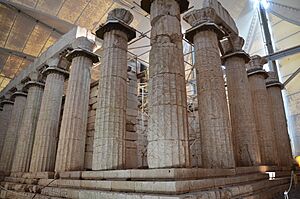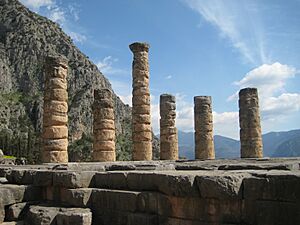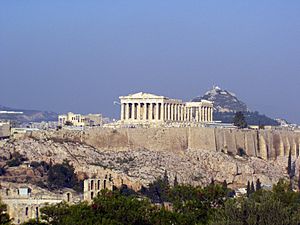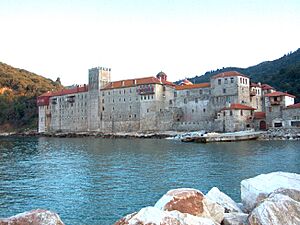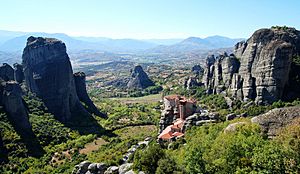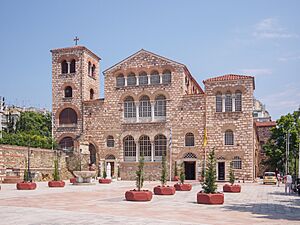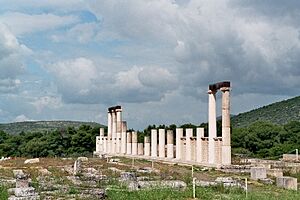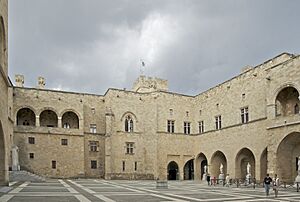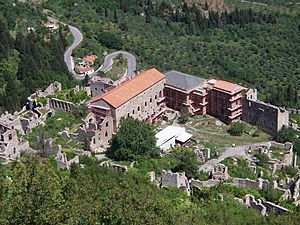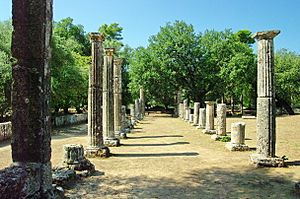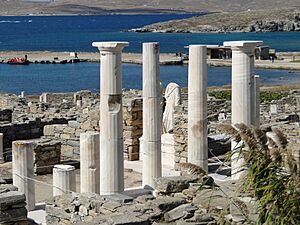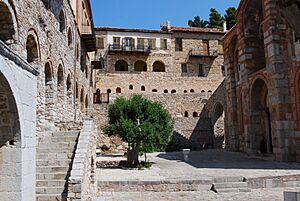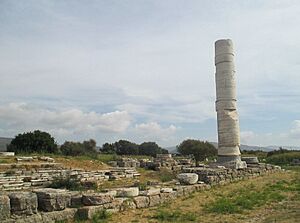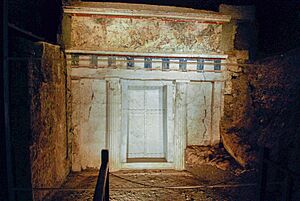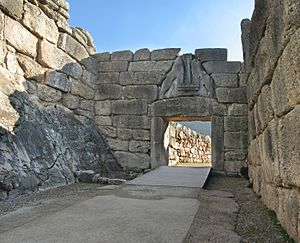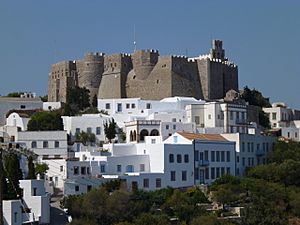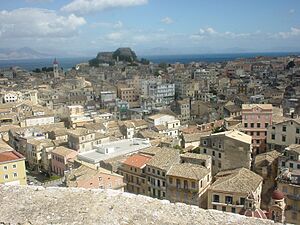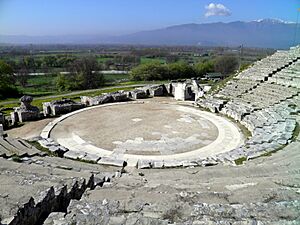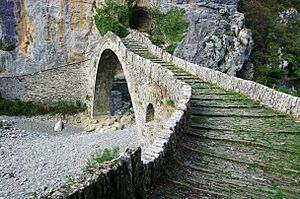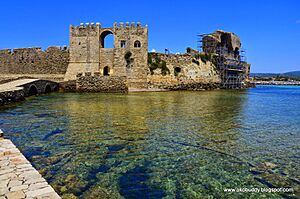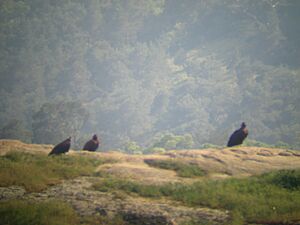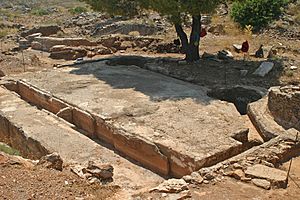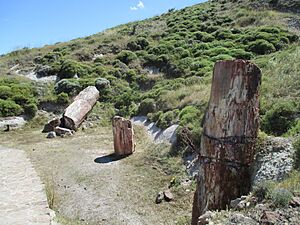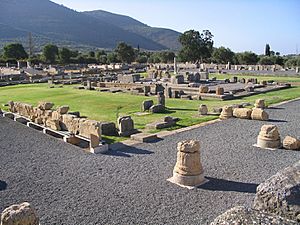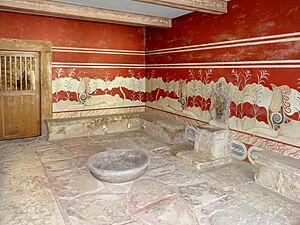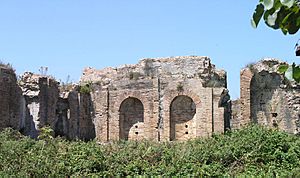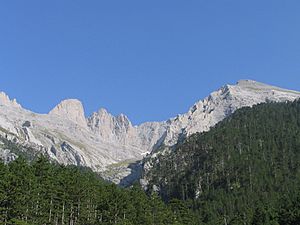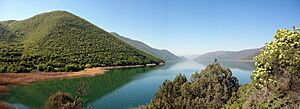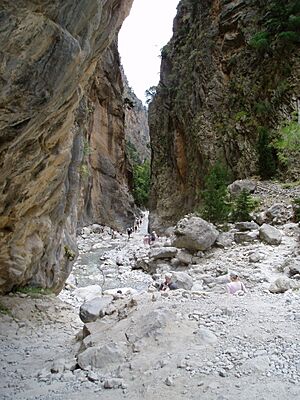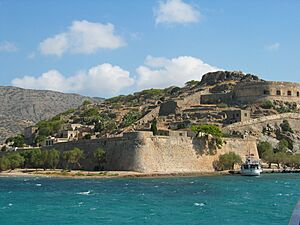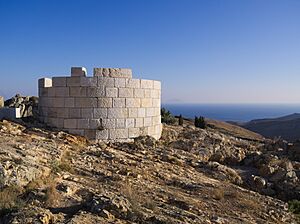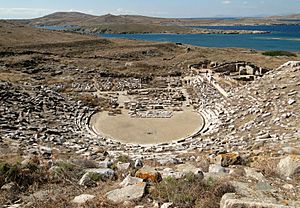List of World Heritage Sites in Greece facts for kids
The United Nations Educational, Scientific and Cultural Organization (UNESCO) helps protect important places around the world. These places are called World Heritage Sites. They are special because of their amazing history, culture, or natural beauty. Countries that agree to the UNESCO World Heritage Convention (started in 1972) can suggest sites.
Cultural sites include old buildings, sculptures, or archaeological areas. Natural sites are places with unique landforms, special plants and animals, or stunning natural views. Greece joined this agreement in 1981. This means its amazing natural and cultural spots can be added to the list.
Greece has 19 World Heritage Sites. Most of them (17) are cultural, like ancient temples or cities. Two sites, Meteora and Mount Athos, are "mixed" sites. This means they are important for both their nature and their culture. The first Greek site added was the Temple of Apollo Epicurius at Bassae in 1986. The newest site, the Zagori Cultural Landscape, was added in 2023. Greece also has 13 sites on a "tentative list." These are places that Greece hopes will become World Heritage Sites in the future.
Greece's World Heritage Sites
UNESCO uses ten rules to pick World Heritage Sites. Each place must meet at least one rule. Rules 1 to 6 are for cultural sites, and rules 7 to 10 are for natural sites.
| Site | Image | Location | Year listed | UNESCO details | What makes it special |
|---|---|---|---|---|---|
| Temple of Apollo Epicurius at Bassae | Peloponnese | 1986 | 392; i, ii, iii (cultural) | This temple was built for the god Apollo in the 5th century BCE. It is in the mountains of Arcadia. UNESCO says it is one of the best-kept ancient Greek buildings. It was the first temple to use all three main Greek column styles: Doric, Ionic, and Corinthian. People forgot about it for almost 1700 years until it was found again in the 18th century. | |
| Archeological site of Delphi | Central Greece | 1987 | 393; i, ii, iii, iv, vi (cultural) | Delphi is at the foot of Mount Parnassus. It was home to the Temple of Apollo and was a very important religious center. Ancient Greeks believed it was the "center of the world." The Pythia, a famous oracle, gave advice there. In the 6th century BCE, Delphi was a symbol of unity for the ancient Greek world. | |
| Acropolis, Athens | Attica | 1987 | 404; i, ii, iii, iv, vi (cultural) | The Acropolis in Athens is on a steep hill. It started as a fort but became a holy place for the goddess Athena. After winning against the Persians in the 5th century BCE, the Athenians built many famous buildings here. These include the Parthenon, Erechtheion, and Propylaia. These buildings have inspired many modern architects. | |
| Mount Athos | Mount Athos | 1988 | 454; i, ii, iv, v, vi, vii (mixed) | Mount Athos is on a narrow peninsula. It has been a special self-governing area since Byzantine times. It became an Orthodox religious center in the 10th century. Today, about 20 monasteries are still active there. Mount Athos has greatly influenced religious buildings and paintings. | |
| Meteora | Thessaly | 1988 | 455; i, ii, iv, v, vii (mixed) | Meteora has amazing sandstone rock formations. Many of its 24 Orthodox monasteries were built on these hard-to-reach peaks. This happened in the 15th century when people wanted to live like hermits again. The monasteries have beautiful 16th-century paintings called frescoes. These are important examples of post-Byzantine art. | |
| Paleochristian and Byzantine monuments of Thessaloniki | Central Macedonia | 1988 | 456; i, ii, iv (cultural) | Thessalonika was one of the first places where Christianity spread. This site includes several churches built from the 4th to the 15th century. It also has old city walls and the Rotunda. The Rotunda was built by Roman Emperor Galerius and later became a church. | |
| Sanctuary of Asklepios at Epidaurus | Peloponnese | 1988 | 491; i, ii, iii, iv, vi (cultural) | People started worshipping Asklepios, the god of medicine, in Epidaurus around the 6th century BCE. The main buildings here are the Temple of Asclepius, the Tholos, and the Theatre. The theatre is thought to be the best ancient Greek theatre. This sanctuary is important in the history of medicine. It shows how people started to believe in science instead of just divine healing. | |
| Medieval City of Rhodes | South Aegean | 1988 | 493; ii, iv, v (cultural) | The Knights Hospitaller lived on the island of Rhodes from 1309 to 1523. They built strong walls around the city, about 4 kilometers long. The Upper town has many Gothic buildings. These include the Palace of the Grand Masters. When the Ottomans took over, they changed most churches into mosques. | |
| Archeological site of Mystras | Peloponnese | 1989 | 511; ii, iii, iv (cultural) | The town of Mystras grew around a fortress built in 1249. It is on the slopes of Mount Taygetus. In 1262, it became part of the Byzantine Empire and became very rich and important. Later, the Ottomans and then the Venetians took control. After 1834, people moved to the new town of Sparta, and Mystras became ruins. | |
| Archeological site of Olympia | West Greece | 1989 | 517; i, ii, iii, iv, vi (cultural) | In the 10th century BCE, Olympia became a center for worshipping Zeus. It was a holy place for all Greeks and the home of the ancient Olympic Games. The games started here in 776 BCE. Besides many temples, the site has remains of sports buildings, like its stadium. | |
| Delos | South Aegean | 1990 | 530; ii, iii, iv, vi (cultural) | According to Greek myths, Delos is the birthplace of Apollo and Artemis. This holy island was a very important religious center during ancient Greek times. The sanctuary of Apollo brought many visitors from all over Greece. This made Delos a busy trading port. It started to decline after 69 BCE. | |
| Monasteries of Daphni, Hosios Loukas and Nea Moni of Chios | Central Greece, Attica, North Aegean | 1990 | 537; i, iv (cultural) | These three monasteries are in different parts of Greece. But they are great examples of Byzantine religious buildings from the middle period. They all have a similar beautiful style. All three churches have an octagonal shape. They were decorated with marble and mosaics in the 11th and 12th centuries. The Monastery of Hosios Loukas is shown in the picture. | |
| Pythagoreion and Heraion of Samos | North Aegean | 1992 | 595; ii, iii (cultural) | The island of Samos was in a key spot in the Aegean islands, close to Asia Minor. It was a strong naval and trading power, especially in the 6th century BCE. This site includes the old fortified city (Pythagoreion) and the ancient Temple of Hera (Heraion). Samos is also linked to famous thinkers like Pythagoras and Epicurus. | |
| Archaeological Site of Aigai (modern name Vergina) | Central Macedonia | 1996 | 780; i, iii (cultural) | The ancient city of Aigai was the first capital of the Kingdom of Macedon. It has a grand palace with beautiful mosaics. There is also a burial ground with over 300 ancient burial mounds. One of these mounds is believed to be the tomb of Philip II of Macedon, who was the father of Alexander the Great. | |
| Archaeological site of Mycenae and Tiryns | Peloponnese | 1999 | 941; i, ii, iii, iv, vi (cultural) | Mycenae and Tiryns were two of the most important cities in Mycenean Greece. They were powerful from the 15th to the 12th centuries BCE. These cities had grand buildings like the Lion's Gate and the Treasury of Atreus. Ancient clay tablets found here are the first writings of the Greek language. Both cities are famous from the Homeric poems, the Iliad and the Odyssey. | |
| The Historic Centre (Chorá) with the Monastery of Saint-John the Theologian and the Cave of the Apocalypse on the Island of Pátmos | South Aegean | 1999 | 942; iii, iv, vi (cultural) | The Monastery of Saint-John the Theologian is on the island of Pátmos. Christians believe that Saint John wrote his Gospel and the Apocalypse here. The monastery was built in the late 10th century. It has been a holy place and a center for Greek Orthodox learning ever since. The old town of Chorá, near the monastery, has many old religious and regular buildings. | |
| Old Town of Corfu | Ionian Islands | 2007 | 978; iv (cultural) | The Old Town of Corfu started around the 8th century BCE. It is at the entrance to the Adriatic Sea. The city was important for the Republic of Venice to protect its sea trade from the Ottoman Empire. Venetian engineers built three forts in the town. Most buildings in the Old Town are from the Venetian period or the 19th century. | |
| Archaeological Site of Philippi | Eastern Macedonia and Thrace | 2016 | 1517; iii, iv (cultural) | Philippi was founded in 356 BCE by Philip II of Macedon. It was on the important Roman road, the Via Egnatia. It was also the site of the Battle of Philippi in 42 BCE. The Romans rebuilt it to look like a "small Rome." They added public buildings like a Forum. After Apostle Paul visited in 49–50 CE, it became an early center for Christians. | |
| Zagori Cultural Landscape | Epirus | 2023 | 1695; v (cultural) | This special area in the Pindus mountains is along the Voidomatis river. It has 45 villages built from stone. These villages are connected by old cobblestone paths and stone bridges. These bridges helped people travel across the difficult mountain land. |
Sites Greece Hopes to Add (Tentative List)
Countries can also make a list of sites they might want to nominate for World Heritage status later. This is called a "tentative list." A site must be on this list before it can be officially nominated. Greece has 13 sites on its tentative list, all added in 2014.
| Site | Image | Location | Year listed | UNESCO rules | What makes it special |
|---|---|---|---|---|---|
| Late Medieval Bastioned Fortifications in Greece | 9 locations | 2014 | ii, iv, v (cultural) | Fortress designs changed when gunpowder became common. This list includes nine forts with special bastions. These forts were built in areas that often changed hands between the Venetians and Ottomans. The Old Town of Corfu is already a World Heritage Site. The fort at Methoni is pictured. | |
| National Park of Dadia – Lefkimi – Souflion | Eastern Macedonia and Thrace | 2014 | x (natural) | This forest in the Rhodope Mountains is home to many birds of prey. It has three of Europe's four types of vultures: Egyptian vulture, Griffon vulture, and Cinereous vulture. It is also an important stop for birds migrating across Europe. | |
| Ancient Lavrion | Attica | 2014 | ii, iv (cultural) | People have been mining in the Lavrion area since 4000 BCE. Mining continued here until the 20th century. In ancient times, the silver from these mines helped pay for buildings in Athens. It also helped build the powerful Athenian navy. The site shows remains of the mines and related industries. | |
| Petrified Forest of Lesvos | North Aegean | 2014 | vi, vii, viii, x (mixed) | The island of Lesbos had a mixed sub-tropical forest about 18.5 million years ago. Volcanic eruptions covered the area, preserving plants as fossils. Famous thinkers like Aristotle and Theophrastus studied this area. They wrote important texts about nature and science. | |
| Archaeological site of Ancient Messene | Peloponnese | 2014 | i, iii, vi (cultural) | Messene is in a fertile valley near Mount Ithome. The first temples here date back to the 9th and 8th centuries BCE. The city of Ancient Messene was founded in 369 BCE. This site is very well-preserved because it was not destroyed or built over by later towns. | |
| Minoan Palatial Centres (Knossos, Phaistos, Malia, Zakros, Kydonia) | Crete | 2014 | ii, iii, vi (cultural) | This site includes the most important palace centers of the Minoan civilization. The Minoans were a major power in the Bronze Age. They had a huge influence on cultures around the East Mediterranean. They are also part of ancient myths like Daedalus and Icarus and the Labyrinth. | |
| Archaeological site of Nikopolis | Epirus | 2014 | ii, iv, vi (cultural) | The city of Nikopolis was founded by Emperor Augustus after a battle in 31 BCE. It was a typical Roman colony in Greece and was used until the 13th century. It was also an early center for Christians. You can still see remains of old buildings and a 50-kilometer long aqueduct. | |
| The broader region of Mount Olympus | Thessaly, Central Macedonia | 2014 | vi, viii, ix, x (mixed) | Mount Olympus is the highest mountain in Greece, at 2,918 meters. It is famous as the home of the Olympian gods. Many places of worship were built on its slopes. The area is important for its mountain plants and animals, and its unique geology. | |
| The area of the Prespa Lakes: Megali and Mikri Prespa which includes Byzantines and post – Byzantine monuments | Western Macedonia | 2014 | ii, iv, vii, ix, x (mixed) | The Prespa Lakes area has many different habitats, like wetlands and forests. This means it has a rich variety of plants and animals. The lakes are home to the largest group of Dalmatian pelicans. Many churches were built here during Byzantine times and later. Small Prespa Lake is pictured. | |
| Gorge of Samaria National Park | Crete | 2014 | vii, viii, ix, x (natural) | The Samaria gorge is one of the deep gorges in the Lefka Ori mountains in western Crete. The area has diverse environments, from mountains over 2000 meters high to the coast. It also has deep caves. These places are home to the Cretan goat and other unique animals like the bearded vulture. | |
| Fortress of Spinalonga | Crete | 2014 | i, ii, iv, vi (cultural) | Spinalonga is a rocky island off the coast of Crete. During the Venetian period, a fortress was built here to protect the port of Elounda. The Ottomans took the island in the 18th century. In the early 20th century, it was used as a leper colony. | |
| Ancient Towers of the Aegean Sea | North Aegean, South Aegean | 2014 | iii, iv (cultural) | This list includes ten ancient towers found on the Aegean Islands and the mainland. Most were built in the 4th and 3rd centuries BCE. They were built outside cities for defense, sometimes as part of bigger fort systems. They also served as watchtowers and lighthouses. The White Tower at Serifos is pictured. | |
| Ancient Greek Theatres | 15 sites | 2014 | i, ii, iii, iv, v, vi (cultural) | This list includes 15 Greek theatres across Greece. Theatres were a key part of ancient Greek cities. They got their full architectural shape in the 4th century BCE. Some of these theatres are already part of existing World Heritage Sites. These include the Theatre of Epidaurus, the Theatre of Delphi, and the Theatre of Delos (pictured). |
See also
 In Spanish: Anexo:Patrimonio de la Humanidad en Grecia para niños
In Spanish: Anexo:Patrimonio de la Humanidad en Grecia para niños
- List of Intangible Cultural Heritage elements in Greece
- Tourism in Greece


